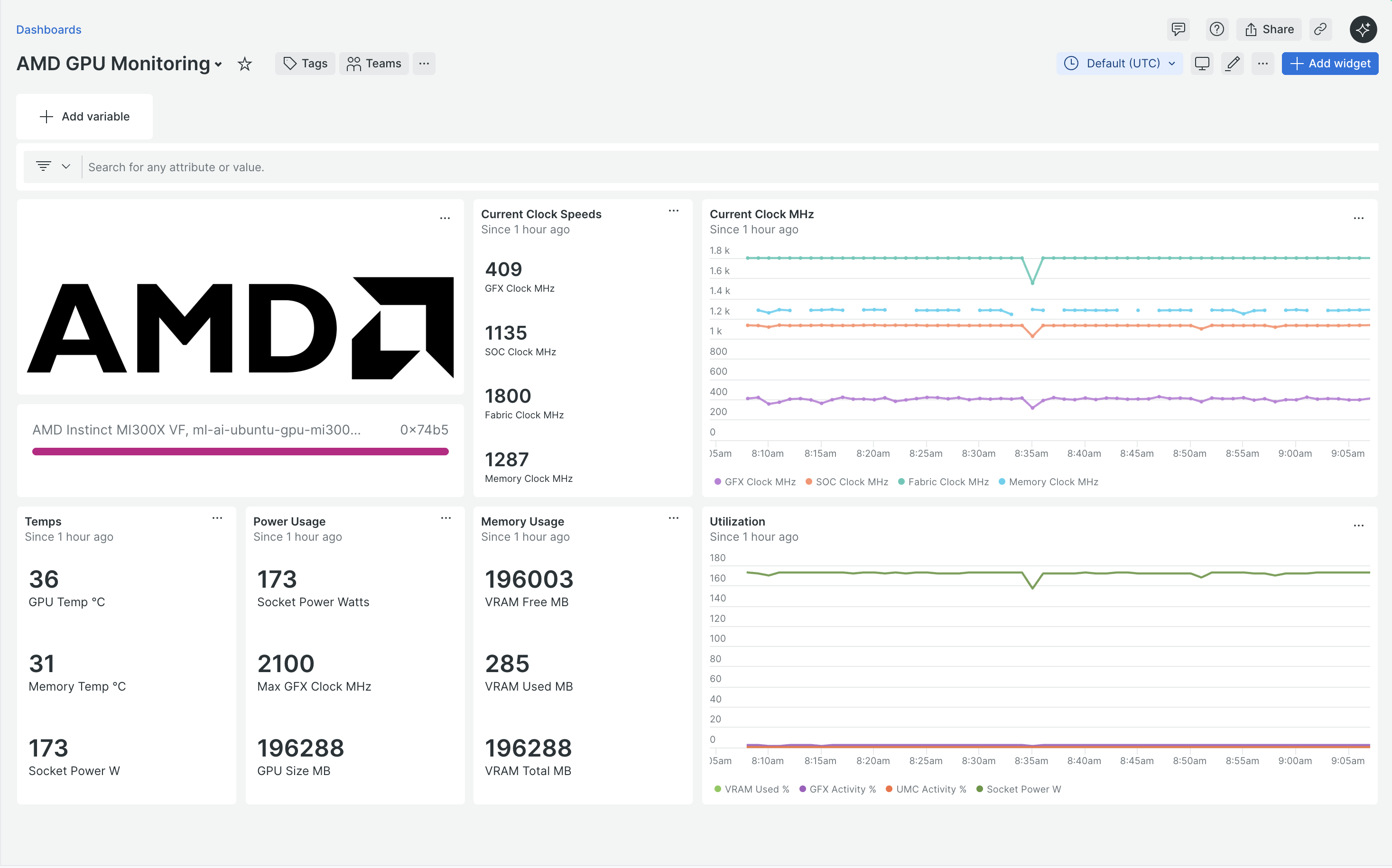Our AMD GPU integration uses our infrastructure agent with the Flex integration, which lets us access AMD's SMI utility.

After you set up our AMD GPU integration, you see a dashboard for your GPU metrics.
When you install, you'll get a pre-built dashboard containing crucial GPU metrics:
- GPU utilization
- Memory usage and availability
- Active compute processes
- Clock frequencies
- Temperature monitoring
- Power consumption
- Performance states
- Dynamic and static information about each supported device
Install the infrastructure agent
To capture data with New Relic, install our infrastructure agent. Our infrastructure agent collects and ingests data so you can keep track of your GPU performance.
You can install the infrastructure agent two different ways:
- Our guided install is a CLI tool that inspects your system and installs the infrastructure agent alongside the application monitoring agent that best works for your system. To learn more about how our guided install works, refer to Guided install overview.
- If you'd rather install our infrastructure agent manually, follow the tutorial for manual installation for Linux, Windows.
Install AMD SMI
Before configuring the Flex integration, install AMD's SMI utility:
Ubuntu/Debian:
$# Add AMD GPU repository$wget -q -O - https://repo.radeon.com/rocm/rocm.gpg.key | sudo apt-key add -$echo 'deb [arch=amd64] https://repo.radeon.com/rocm/apt/debian/ ubuntu main' | sudo tee /etc/apt/sources.list.d/rocm.list$
$# Update and install$sudo apt update$sudo apt install amd-smiRHEL/CentOS/Fedora:
$# Add AMD GPU repository$sudo tee /etc/yum.repos.d/rocm.repo <<EOF$[ROCm]$name=ROCm$baseurl=https://repo.radeon.com/rocm/yum/rpm$enabled=1$gpgcheck=1$gpgkey=https://repo.radeon.com/rocm/rocm.gpg.key$EOF$
$# Install AMD SMI$sudo yum install amd-smiImportant
After installation, ensure the amd-smi binary is accessible in your system PATH and your user has proper permissions to access GPU devices.
Configure Flex integration for AMD GPUs
Flex comes bundled with the New Relic infrastructure agent and can be integrated with AMD SMI, a command line utility to monitor AMD GPU devices.
Follow these steps to configure Flex:
Create a file named
amd-smi-gpu-monitoring.ymlin this path:bash$sudo touch /etc/newrelic-infra/integrations.d/amd-smi-gpu-monitoring.ymlYou may also download from the git repository.
Update the
amd-smi-gpu-monitoring.ymlfile with the integration config:Copy the file content (
.yml) from the AMD SMI GPU monitoring configuration and paste it into your configuration file.
Confirm GPU metrics are being ingested
The Flex configuration will be automatically detected and executed by the infrastructure agent, there's no need to restart the agent. You can confirm metrics are being ingested by running this NRQL query:
SELECT * FROM AMDGpuSampleMonitor your application
You can create custom dashboards to monitor your AMD GPU metrics. Here are some example NRQL queries to get you started:
GPU Utilization
SELECT average(gfx_activity_percent) FROM AMDGpuSample TIMESERIES AUTO FACET gpu_idMemory Usage
SELECT average(vram_used_mb), average(vram_total_mb), average(vram_free_mb) FROM AMDGpuSample TIMESERIES AUTO FACET gpu_idTemperature Monitoring
SELECT average(temp_edge_c), average(temp_hotspot_c), average(temp_mem_c) FROM AMDGpuSample TIMESERIES AUTO FACET gpu_idPower Consumption
SELECT average(socket_power_w), max(max_power_w) FROM AMDGpuSample TIMESERIES AUTO FACET gpu_idClock Frequencies
SELECT average(gfx_0_clk_mhz), average(mem_0_clk_mhz), average(fclk_0_clk_mhz) FROM AMDGpuSample TIMESERIES AUTO FACET gpu_idGPU Activity by Type
SELECT average(gfx_activity_percent), average(umc_activity_percent), average(mm_activity_percent) FROM AMDGpuSample TIMESERIES AUTO FACET gpu_idECC Error Monitoring
SELECT sum(ecc_total_correctable), sum(ecc_total_uncorrectable) FROM AMDGpuSample TIMESERIES AUTO FACET gpu_idPCIe Performance
SELECT average(pcie_bandwidth_mb_s), average(pcie_current_bandwidth_sent), average(pcie_current_bandwidth_received) FROM AMDGpuSample TIMESERIES AUTO FACET gpu_idTo create a comprehensive dashboard:
- Go to one.newrelic.com and click on Dashboards.
- Click Create a dashboard.
- Add charts using the NRQL queries provided above.
- Customize your dashboard layout and save it.
For docs on using and editing dashboards, refer to our dashboard docs.
Troubleshooting
Common issues and solutions:
AMD SMI not found:
- Ensure AMD SMI is properly installed and accessible in your PATH
- Verify AMD SMI with:
amd-smi version
Permission denied errors:
- Ensure your user has proper permissions to access GPU devices
- You may need to add your user to the
rendergroup:bash$sudo usermod -a -G render $USER - Log out and log back in for changes to take effect
No GPU detected:
- Verify AMD GPU is detected by the system:
lspci | grep -i amd - Check if amdgpu driver is loaded:
lsmod | grep amdgpu - Ensure your AMD GPU is supported by AMD SMI
Missing metrics:
- Some older AMD GPUs may not support all sensors
- Check which metrics are available:
amd-smi metric --help - Verify GPU compatibility:
amd-smi list
What's next?
You can adapt the Flex configuration to include or exclude information available from the AMD SMI utility. Additional AMD SMI options include:
amd-smi list- List available GPU devicesamd-smi static- Static GPU informationamd-smi metric- Real-time GPU metricsamd-smi process- Process information using GPUamd-smi monitor- Continuous monitoring mode
To learn more about building NRQL queries and generating dashboards, refer to these docs:
- Introduction to the query builder to create basic and advanced queries.
- Introduction to dashboards to customize your dashboard and carry out different actions.
- Manage your dashboard to adjust your display mode, or to add more content to your dashboard.